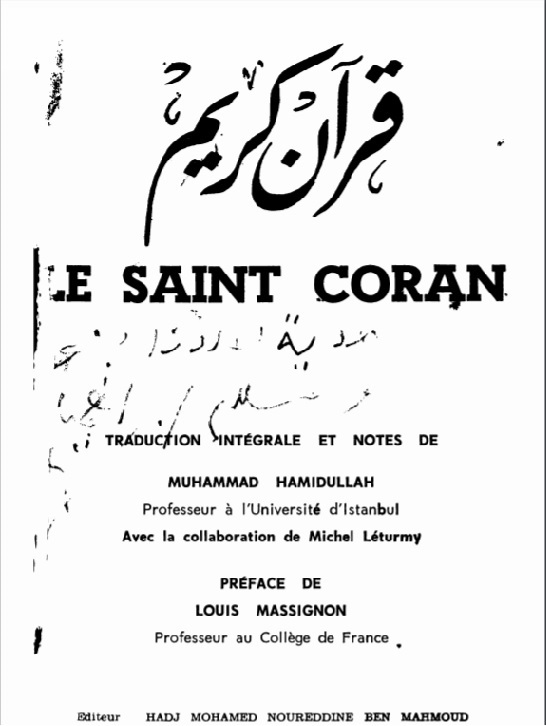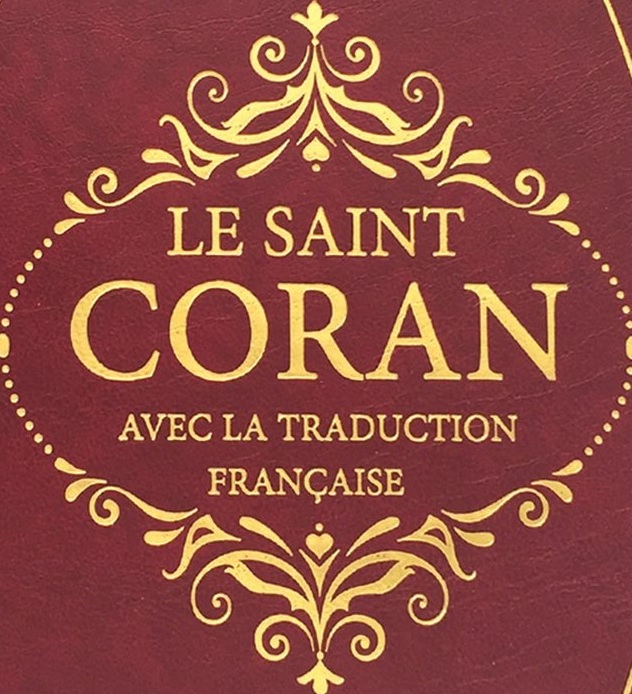
It would be no exaggeration to say that just as Abdullah Yusuf Ali’s translation of the Qur’an is widely known and used in the Anglophone world, the same applies to Professor Muhammad Hamidullah’s scholarship – Le Saint Coran – amongst French speakers. It was a work first published in 1959, with its introductory pages acknowledging the collaboration with Michel Léturmy. While it is possible to construct a biographical portrait of Hamidullah from his writings, interviews and recollections of students, much less is known about Léturmy in Muslim circles.
The story begins with Professor Hamidullah’s long residence in Paris, where he settled permanently in 1947 at the age of 39. Prior to that, he had been a student at the Osmania University in Hyderabad Deccan – he was its youngest student when joining the Department of Theology in 1924 at the age of fifteen. In 1932 he obtained the Nizam of Hyderabad’s scholarship to proceed for further studies to Germany and France. He was awarded a PhD from Bonn University for a thesis, ‘Islamic International Law ‘. Its high standard prompted an invitation to Paris, where Professor Massignon arranged for admission to the Sorbonne University. Hamidullah obtained a D.Litt. degree with distinction in 1935, after a rigorous viva that required him to deliver lectures on ‘Ancient Arabian Fairs’ and ‘The theory of non-alignment in Islamic International law’. During his stay he visited the exiled Caliph Abdul Majid II in Nice and was given letters to take back to his daughter, Ayşe Dürrüşehvar Sultana, who had married Azam Jah, the eldest son of the Nizam, a few years earlier.
This was a period in which the future political map of British India was being debated. Nizam’s Hyderabad was a prosperous principality, with a degree of autonomy from the Raj. It had its own currency, airline, railway and army, albeit affairs were closely watched by the British Political Resident. The Nizam was a patron of learning, and scholars world-wide found Hyderabad a congenial setting – including, for example, Muhammad Marmaduke Pickthall. During the Round Table Conferences in London in the 1930-32 period, the Nizam’s delegation pressed for Hyderabad and the other princely states for autonomy within a federation, with paramountcy not to an Indian Government, but through the Nizam’s relationship with the Crown.
From 1935 to 1938, Hamidullah taught at Osmania University. He was a member of a delegation sent by the Nizam to alert the world that the independence of Hyderabad was in jeopardy after the Partition, because the pledges of paramountcy had been abandoned by the British Government, leaving the princely states to their fate. He was abroad when the Indian army entered Hyderabad in September 1948 and sought asylum in Paris. He refused to visit Britain because of its broken pledge to the Nizam.
Professor Hamidullah was part of a body set up to advice the Constituent Assembly in framing a constitution for Pakistan in 1949-50, and also contributed to the seminal document ‘Basic Principles of an Islamic State’. However, he did not find conditions to his liking and returned to France. From 1954 to 1978 he was a Research Fellow at the Centre National de la Recherche Scientifique and visiting professor at Turkish and Malaysian universities. He never married and lived a spartan life in a small flat, 4 Rue de Tournon, Paris VI. He published extensively, including classics such as ‘Battlefields of the Prophet’ and the two volume Le Prophete de l’Islam. He led a regular weekly circle on Wednesday evenings at the Paris Mosque for decades which was a formative influence for generations of students, particularly in the 1960s.

When his translation of the Qur’an into French was published, Massignon provided a foreword, noting “the major interest of this translation of the Qur’an is that it is the thoughtful work of a Muslim, a thinker and a believer: that this Holy Book is personally concerned. He lives it, he wants to translate it into French as he recites in Arabic, with untrammeled faith [une foi nue]”.
His collaborator in this work, Michel Léturmy, was born in 1921 in a district of Pays de la Loire, west of Paris. There are only the briefest of mentions to him in the biographical essays on Professor Hamidullah or reviews of Le Saint Coran. For example, the comprehensive ‘Critical Study of Dr. Muhammad Hamidullah’s French Translation’, by Dr. Muhammad Sultan Shah, published in 2018, has one sentence referring to the joint effort: “The French translation of the Qur’an was carried out by Dr. Muhammad Hamidullah in collaboration with a French scholar M. Leturmy who took care of the literary aspect of the translation.”
Léturmy’s story is also remarkable: during World War II, when France was defeated by the German army, he was a novice Catholic priest taken to Germany. When the Russians entered the country, he was put to work as a construction labourer. It is in this setting that he began to sympathise with workers’ rights. After the war, he returned to France and joined a monastic order. He was assigned as a priest in an industrial suburb of Paris, where he came into contact with immigrant workers, including Algerians. He began developing his own way of explaining the Old Testament, which led to punitive measures by his Order – forced labour in a farm. In Pour Mémoire he writes that his bookshelf angered the hierarchy even further for their anti-clerical bent: “Gorky next to Koestler, Ghéorghiu next to Abbot Godin”. He was sent by the Church Fathers to work as a missionary in Algeria and then Cameroon, but his continued fraternisation with the local population was found unacceptable. He was recalled and asked to “regularise his situation”. In his memoir, he describes an interview with a Father Superior. He was told that to leave the Church, permission had to be obtained from Rome: “I thought of the Kingdom of God [. . .] why was Christ defrocked by the synagogue [. . .] it seems less of God, more of the Empire”.
He was defrocked in 1953 for suspect Protestant and Marxist tendencies. He married the following year and embarked on a career as writer and translator, drawing on his knowledge of Greek, Latin, and Arabic. He worked for the publisher Gallimard and wrote numerous book reviews and obituaries for its Nouvelle Revue francais. Among his books was Abraham a vue ma jour [Abraham saw my day], in which he attempted to show the human aspect of the great Prophet – “a man of today, in direct contact with the unfathomable problems of a religious faith of which he is both the inevitable master and the worried slave”.
A close friend was the poet Jean Grosjean, like him a former priest and classicist, with whom he published a translation of the New Testament from the Greek. Grosjean also translated the Qur’an – a bit like a French Arberry, seeking to convey its poetic magnificence. Likewise, Léturmy “co-authored” the translation of the Qur’an with Hamidullah. He passed away in February 2000, two years prior to Hamidullah’s own demise.
Perhaps readers of this blog may have some information on how the two met, and what prompted this partnership? After all, Professor Hamidullah had access to a wide circle of Muslim scholars with expertise in the French language who would have been all too ready to help – if it was help, he needed in correcting his French. Could it be that their common acquaintanceship with Najmuddin Bammate, the Chechen leader in exile in Paris, and a distinguished scholar in his own right, played a role? The author is aware that many of Professor Hamidullah’s papers are at the IRCICA Library, Yildiz Palace, in Istanbul, where an answer might be found. Further research is awaited!
Jamil Sherif, October 2020
Further reading & sources:
Remembering Professor Muhammad Hamidullah – selections from Impact International http://www.salaam.co.uk/wp-content/uploads/2019/08/Vol-33-No1to3-pp14to44v2-compressed.pdf
Pour Mémoire by Michel Léturmy, Gallimard, Paris; 1961.
Dr. Muhammad Sultan Shah, ‘ Critical Study of Dr. Muhammad Hamidullah’s French Translation’ , Afkar, Research Journal of Islamic & Religious Studies, Institute of Social Sciences and Development, Karach, Vol. 2, Issue 1, June 2018,
